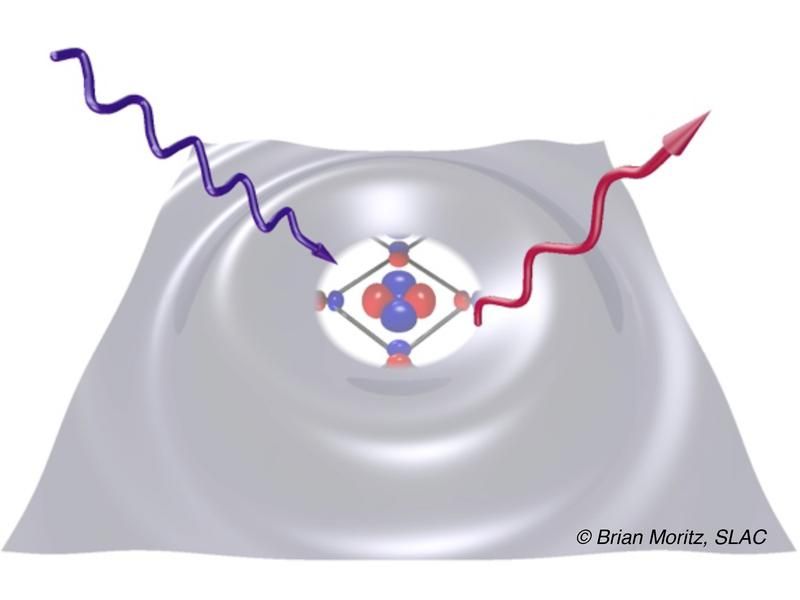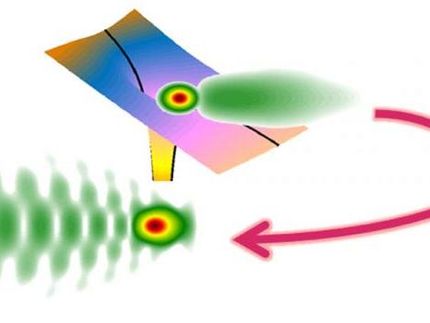Laser pulses help scientists tease apart complex electron interactions
Time-resolved “stop-action” measurements and advanced theoretical simulations identify an unusual form of energy loss

A first laser pulse excites a solid; a second pulse knocks out electrons that travel to a detector. The resulting pictures allow scientists to learn about fundamental interactions inside the solid.
© Brian Moritz / SLAC
Understanding the properties of complex quantum materials is a major goal of condensed matter physics and materials science, since effects like high-temperature superconductivity might lead to a broad range of applications. Now an international team of scientists including Emmy Noether group leader Michael Sentef from the Max Planck Institute for the Structure and Dynamics of Matter at CFEL in Hamburg has demonstrated a new laser-driven “stop-action” technique for studying complex electron interactions under dynamic conditions. The findings, published in the journal Nature Communications today, are expected to improve the understanding of the physical processes leading to emergent phenomena in strongly correlated materials.
Scientists studying high temperature superconductors—materials that carry electric current with no energy loss when cooled below a certain temperature—have been searching for ways to study in detail the electron interactions thought to drive this promising property. One big challenge is disentangling the many different types of interactions—for example, separating the effects of electrons interacting with one another from those caused by their interactions with the atoms of the material.
In the present study, the researchers used one very fast, intense “pump” laser to give electrons a blast of energy, and a second “probe” laser to measure the electrons’ energy level and direction of movement as they relax back to their normal state. “By varying the time between the ‘pump’ and the ‘probe’ laser pulses we can build up a stroboscopic record of what happens—a movie of what this material looks like from rest through the violent interaction to how it settles back down,” said Jonathan Rameau, physicist at the Brookhaven National Laboratory and one of the lead authors on the paper. “It’s like dropping a bowling ball in a bucket of water to cause a big disruption, and then taking pictures at various times afterward,” he explained.
The technique, known as time-resolved, angle-resolved photoelectron spectroscopy (tr-ARPES), combined with complex theoretical simulations and analysis, allowed the team to tease out the sequence and energy “signatures” of different types of electron interactions. They were able to pick out distinct signals of interactions among excited electrons (which happen quickly, but don’t dissipate much energy), as well as later-stage random interactions between electrons and the atoms that make up the crystal lattice (which generate friction and lead to gradual energy loss in the form of heat).
But they also discovered another, unexpected signal—which they say represents a distinct form of extremely efficient energy loss—at a particular energy level and timescale between the other two.
“We see a very strong and peculiar interaction between the excited electrons and the lattice, where the electrons are losing most of their energy very rapidly in a coherent, non-random way,” Rameau said. At this special energy level, he explained, the electrons appear to be interacting with lattice atoms all vibrating at a particular frequency—like a tuning fork emitting a single note. When all of the electrons that have the energy required for this unique interaction have given up most of their energy, they start to cool down more slowly by hitting atoms more randomly without striking the resonant frequency, he said. The resonance frequency of this process is particularly noteworthy, the scientists say, because its energy level corresponds with a “kink” in the energy signature of the same material studied previously in its superconducting state using a static form of ARPES.
At that time, scientists suspected the kink might have something to do with the material’s ability to become a superconductor. They couldn’t detect the same signal above the superconducting temperature. But the new time-resolved experiments, which were done on the material well above its superconducting temperature, were able to tease out the subtle signal. These new findings indicate that this special condition exists even when the material is not a superconductor. “We know now that this interaction doesn’t just switch on when the material becomes a superconductor; it’s actually always there,” Rameau said.
Michael Sentef, who complemented the experimental work with numerical simulations, stressed the impact of this work for the field of pump-probe spectroscopy. “This work highlights the fact that we have advanced our theoretical understanding of systems far from thermal equilibrium to the point where we can make quantitative predictions for experiments,” he said. “This insight is very motivating for future work addressing even more complex situations, in which laser pulses are used to induce high-temperature superconducting-like states,” Sentef added.
Original publication
J. D. Rameau, S. Freutel, A. F. Kemper, M. A. Sentef, J. K. Freericks, I. Avigo, M. Ligges, L. Rettig, Y. Yoshida, H. Eisaki, J. Schneeloch, R. D. Zhong, Z. J. Xu, G. D. Gu, P. D. Johnson, and U. Bovensiepen; "Energy Dissipation from a Correlated System Driven Out of Equilibrium"; Nature Comm.; 2016
See the theme worlds for related content
Topic World Spectroscopy
Investigation with spectroscopy gives us unique insights into the composition and structure of materials. From UV-Vis spectroscopy to infrared and Raman spectroscopy to fluorescence and atomic absorption spectroscopy, spectroscopy offers us a wide range of analytical techniques to precisely characterize substances. Immerse yourself in the fascinating world of spectroscopy!

Topic World Spectroscopy
Investigation with spectroscopy gives us unique insights into the composition and structure of materials. From UV-Vis spectroscopy to infrared and Raman spectroscopy to fluorescence and atomic absorption spectroscopy, spectroscopy offers us a wide range of analytical techniques to precisely characterize substances. Immerse yourself in the fascinating world of spectroscopy!


























































